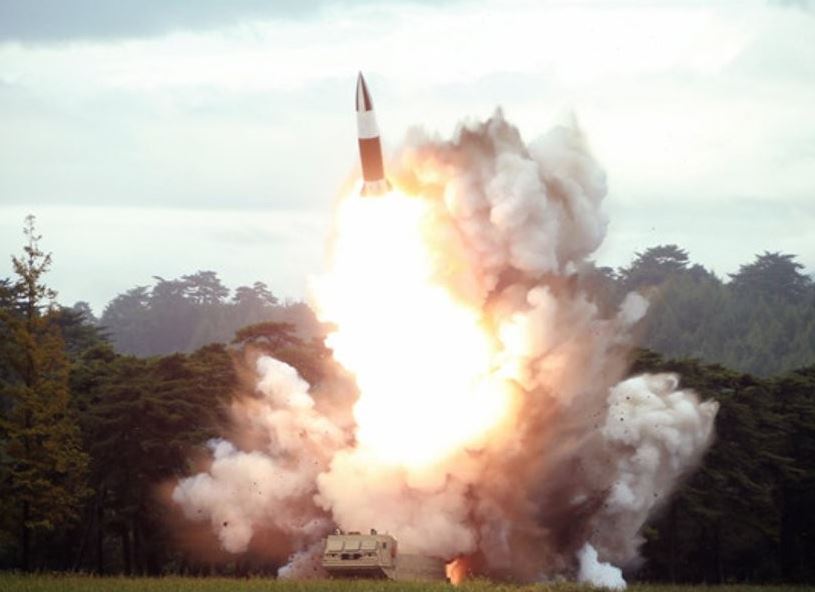North Korea fired what was believed to be a submarine-launched ballistic missile from waters off its east coast on Wednesday, South Korea's military said, demonstrating its nuclear delivery capabilities just days before resuming denuclearization talks with the United States.
The missile, believed to be a type of Pukguksong, a North Korean SLBM, was fired from off the east coast near Wonsan in an easterly direction at 7:11 a.m., and flew around 450 kilometers at a maximum altitude of about 910 km, according to the Joint Chiefs of Staff.
The high altitude means the missile was fired at a high angle, and if it had been fired at a normal angle, it would have flown a much longer distance. "Our military is monitoring the situation in case of additional launches and maintaining a readiness posture," the JCS said, calling on the North to stop such acts that heighten tensions on the Korean Peninsula.
South Korea's presidential National Security Council convened an emergency meeting and expressed strong concern over the launch.
US Forces Korea said it is aware of the launch.

"We are aware of reports of a possible North Korean missile launch. We are continuing to monitor the situation and consulting closely with our allies in the region," USFK spokesperson Col. Lee Peters said in a statement sent to Yonhap News Agency.
The North last conducted an SLBM test when it test-fired a Pukguksong-1 ballistic missile off the east coast in August 2016, which flew about 500 km.
So far, North Korea is believed to have developed Pukguksong-1 and Pukguksong-2 missiles, and their maximum flight range was known to be around 1,300 kilometers, according to the defense ministry.
Along with its intercontinental ballistic missiles, the North's SLBM program is considered one of the biggest threats to the US and its allies, as it could extend the range of the North's nuclear missiles and such a missile is hard to detect in advance before it emerges from the water.
In July, North Korean leader Kim Jong-un inspected a newly built submarine, calling for the development of naval armed forces to boost the country's military capabilities, according to the North's Korean Central News Agency. The communist country was known to have built a new submarine at its naval base in Sinpo on its east coast.
Intelligence authorities in South Korea said at the time that the newly constructed submarine is ready to be deployed "soon" and seems to be capable of carrying three SLBMs. Currently, North Korea is believed to be operating around 70 subs, including some 20 1,800-ton Romeo class ones.
Following Wednesday's launch, South Korea asked Japan to share related military information under the framework of the bilateral intelligence-sharing pact, according to Seoul's defense ministry.
In August, South Korea announced its decision to terminate the pact, the General Security of Military Information Agreement, after Japan extended its export restrictions on Seoul.
The agreement is set to expire in November.
Japan's Chief Cabinet Secretary Yoshihide Suga told a press conference earlier in the day that North Korea launched two ballistic missiles and that one of them fell into the country's exclusive economic zone.
The firing came a day after the North's First Vice Foreign Minister Choe Son-hui said that Pyongyang and Washington agreed to resume working-level nuclear talks this week.
The two sides will have "preliminary contact" on Friday and working-level negotiations the following day, Choe said without disclosing the venue. The US State Department only said the two sides plan to "meet within the next week."
The nuclear talks have been stalled since the breakdown of the summit between US President Donald Trump and North Korean leader Kim Jong-un in Hanoi in February.
"(North Korea) appears to aim to strengthen its negotiating hand to the maximum," Defense Minister Jeong Kyeong-doo said Wednesday during an annual parliamentary audit.
"It also appears to take into consideration multiple factors, including our military's demonstration of its latest military assets yesterday," he added. On Tuesday, South Korea officially marked its introduction of F-35A stealth fighters for the first time during the Armed Forces Day ceremony.
South Korea has so far brought in eight F-35As, beginning with two in late March, under a plan to deploy 40 fifth-generation jets through 2021.
North Korea has intensified its criticism against South Korea for the introduction of such advanced weaponry, claiming that such a military buildup is aimed at destroying North Korea, and it is in violation of last year's inter-Korean military agreement that calls for halting hostility against each other.
Wednesday's firing is the 11th such round of launches by the North so far this year, as it has carried out a succession of missile or rocket firings since May after an 18-month hiatus. The last one took place on Sept. 10 when it is believed to have test-fired two or three projectiles from what it dubbed its "super-large" multiple rocket launcher system.
Covering the news of the firing the following day, the KCNA hinted that more tests could be coming as it said the remaining step is to carry out a test "which is most vivid character in terms of the power of multiple rocket launchers."
During the previous 10 rounds of tests, North Korea was believed to have showed off four new types of weapons: its version of Russia's Iskander ballistic missile, its version of the US' Army Tactical Missile System, "a new large-caliber multiple launch guided rocket system" presumed to be a 400-millimeter one and the super-large launcher. (Yonhap)







![[KH Explains] How should Korea adjust its trade defenses against Chinese EVs?](http://res.heraldm.com/phpwas/restmb_idxmake.php?idx=644&simg=/content/image/2024/04/15/20240415050562_0.jpg&u=20240415144419)











![[Today’s K-pop] Stray Kids to return soon: report](http://res.heraldm.com/phpwas/restmb_idxmake.php?idx=642&simg=/content/image/2024/04/16/20240416050713_0.jpg&u=)